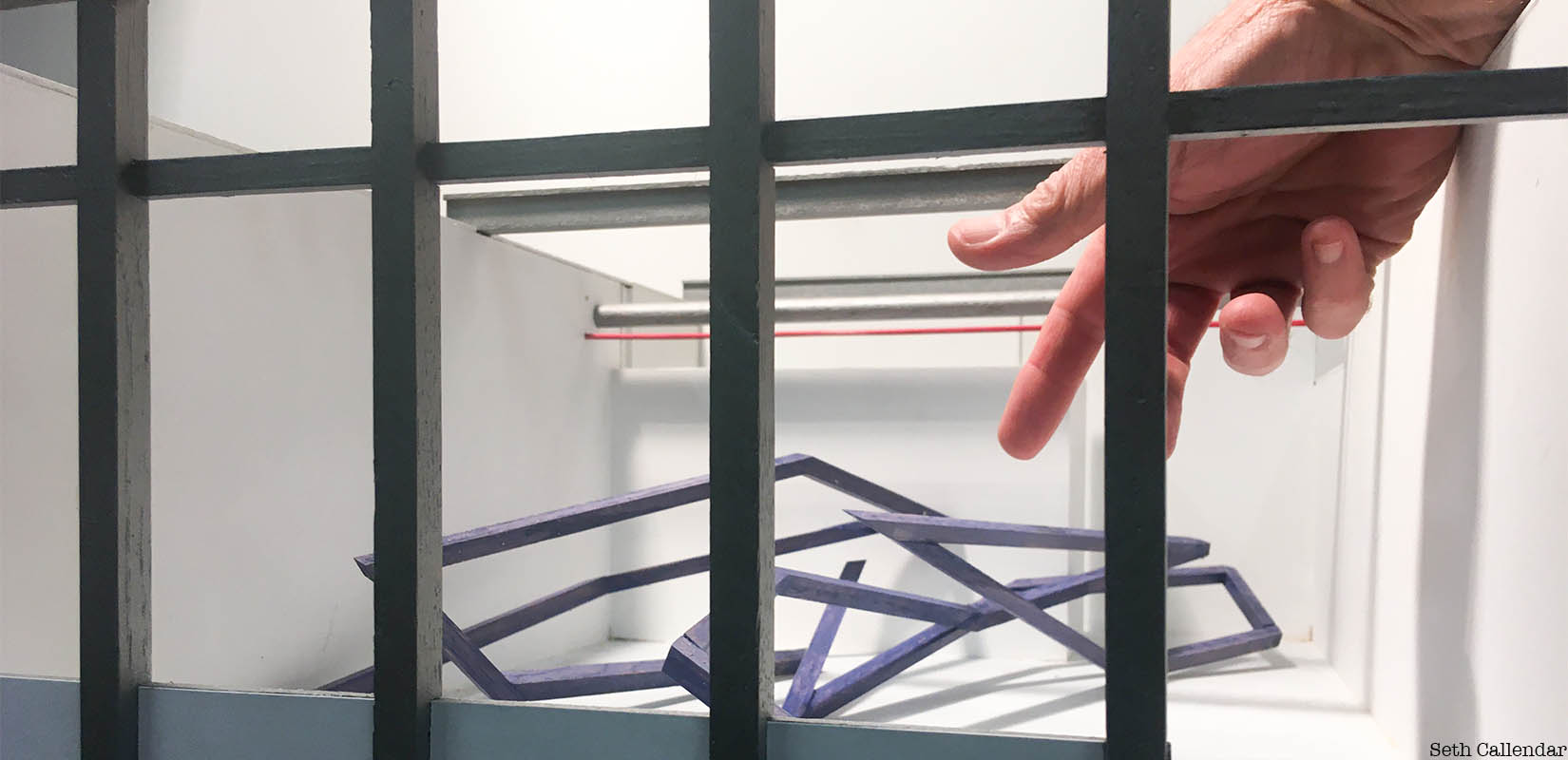On a midmorning early in April sculptor Seth Callander took a coffee and social media break from his woodwork in his recently leased New Haven, Connecticut studio, unaware his life was about to change. Callander, who studied architecture at the University of Oregon, began his art career in New York City in the East Village just as that historic scene was taking off. Although he had wild and productive years in the New York and Los Angeles art scenes, his most recent studio was in the quiet, safe Vermont town of Woodstock where he had moved with his wife when his daughter was little. The Green Mountain State was a picture-perfect place to raise a child, even if the once-exhibiting artist risked falling off the radar of important galleries and collectors in a land of wind chimes.
By early 2020, now divorced and with child grown, Callander spent more time on his sculpture. In the last few years he’s broadened his influences and perfected craft. Artist peers he trusted felt he had hit his professional stride. Maybe he had reached his stride later than other childless artists he had been in the lively New York loft scene with, but now he was ready to get out there and hustle for a new solo show and more grants.
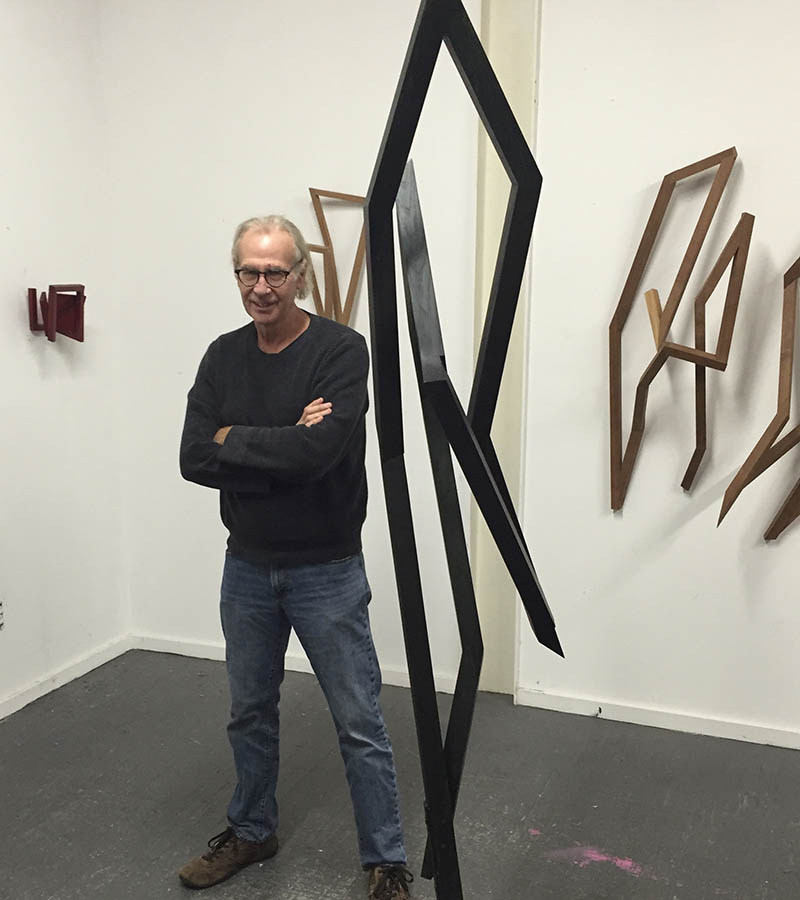 Seth Callandar in his studio in New Haven. Photo by Jack Huber/Huber Design Group.
Seth Callandar in his studio in New Haven. Photo by Jack Huber/Huber Design Group.
Just before lockdown was on everyone’s mind, Callander rolled the dice and relocated to a small New Haven apartment not far from Union Station and secured a studio nearby. Far closer to now outrageously cost-prohibitive New York than bucolic Vermont, New Haven offers a happy compromise: affordable studio spaces full of working, networking artists and the diverse urban population he craved. “Not to mention a great food scene.”
Like many a creative letting a new reality sink in, his enthusiastic New Year’s resolutions were flattened by the daily news about a mysterious disease called Covid-19. Still he was soldiering on, hoping this bold move was not all for naught. His 20-something daughter Sarah had a good career start in D.C. politics now. He was living alone with a clingy cat, but creating was his full time job now. Between outbursts of career anxiety, he had many magnificent ideas he knew he could not follow through on until the world settled down. Catching a career break was an unlikely scenario in a pandemic. He took a few carpentry jobs to pay his rent here too.
But back to that fateful April morning. Callander, an early riser, had just read an interesting article at 6 a.m., about how a Boston gallery was launching a virtual version to get an audience in a lockdown. Callander shared it in a small but active Facebook private group formed by like-minded artists and professionals. All were concerned about the future of the art world when devoted gallery goers were at best making mad masked dashes down the street for essential groceries, or yeast for sourdough.
Several gallery directors, spooked by the state of things, had joined the group too. Even if the galleries reopened in the summer, who would come masked and socially distanced? What kind of experience is that? When the pandemic struck, it left the art world with a murky outlook and for the time being at least, crippled sales. A fated moment perhaps. Also online on this nascent online community at this exact moment as Seth Callander was Harlem’s ODETTA gallery owner Ellen Hackl Fagan.
She posted in the thread and they exchanged nice words. Callander knew her, they had met at an opening and exchanged emails after a friend recommended him to her. Nothing firm had come of that yet, but she was a good person to know. In the rarefied world of New York galleries, not many serve mid-career sculptors.
ODETTA is known for its straightforward emphasis on talent regardless of age. Many sculptors are in their mix as well as painters and installation artists. Fagan, who is also a working artist herself, has gained a hard-won reputation for her stick-to-it-iveness and has used a variety of methods to sell work, often turning to an online approach. She admitted to me by phone that even with great walk-ins, she finds most of her sales are online. Also an early riser, she had seen the same article Callander had posted, and had been musing all morning how to apply the inspiration to her own career. She was comfortable with increasing her gallery’s digital presence until New York sorted itself out.
Fagan had already been thinking how she might best show Callander at a later date. Photos she’s seen of his work suggested influences like Joel Shapiro, David Smith, and the deceased talent Tony Smith — but happily Callander had his own immediately recognizable and marketable style.
But here he was again, online with her. And this was the guy who also mentioned he was also a master carpenter of many years to help pay the rent. He would no doubt sympathize over the headachy task of holding a normal opening in the Coronvirus era. Could he help her build a Lilliputian model to show off work? A miniaturized gallery like that would be a hedge against the endless feeling of gloom. She could show pieces in maquette form and then sell them to collectors in full without anyone risking their health. Maybe she could get good press too. People love Lilliputian worlds.
Fagan had a strong inkling Callander was the exact person to help execute her vision. She had some coffee herself and emailed him. Could they talk about it? He was very glad that the gallerist he’d met in 2019 had reached out. Was she offering him a solo show?
The discussion fueled Callander’s imagination. He could visualize it, and yes he could do this. He could gather the wood and paint, and certainly build the diminutive gallery, a replica of the first ODETTA gallery that was a popular site in Bushwick when Fagan first launched. She asked him to even recreate the red sprinkler pipes from that old space in miniature form. All of this was easy for him. He put aside his own work and built the gallery out of plywood and leftover antique chestnut and painted it to match the gallery’s original scheme.
Fagan was soon speaking to Callander almost every day and the mini gallery became a collaboration of sorts, with a frequent exchange of ideas. Fagan enjoyed talking to him so much she decided to don a mask and make a visit to New Haven. Why not give this guy a proper studio visit? She had liked his works online, but found them even more engaging in person, full of energy and stories. She sensed he could and should be working bigger and commanding more dollars as well. So addition to building her a miniature gallery, she offered him the first show in it. The break he’d wanted.
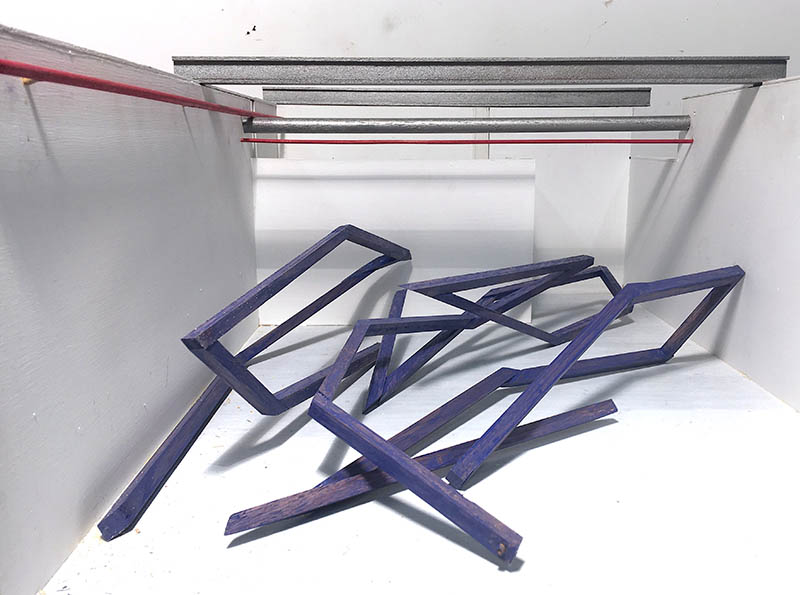 “The Waters We Swim” by Seth Callandar. Photo by Seth Callandar
“The Waters We Swim” by Seth Callandar. Photo by Seth Callandar
The resulting ODETTA Petite at 10 x 24 x16 inches, is about the size of a small microwave and is an astonishing wonderful thing. There are two rooms within. In the main one holds Callander’s “The Waters We Swim” – a 9H x 16W x 24L inches – a work about the size of a twelve-pack of beer, and crafted from white oak painted an almost cerulean blue.
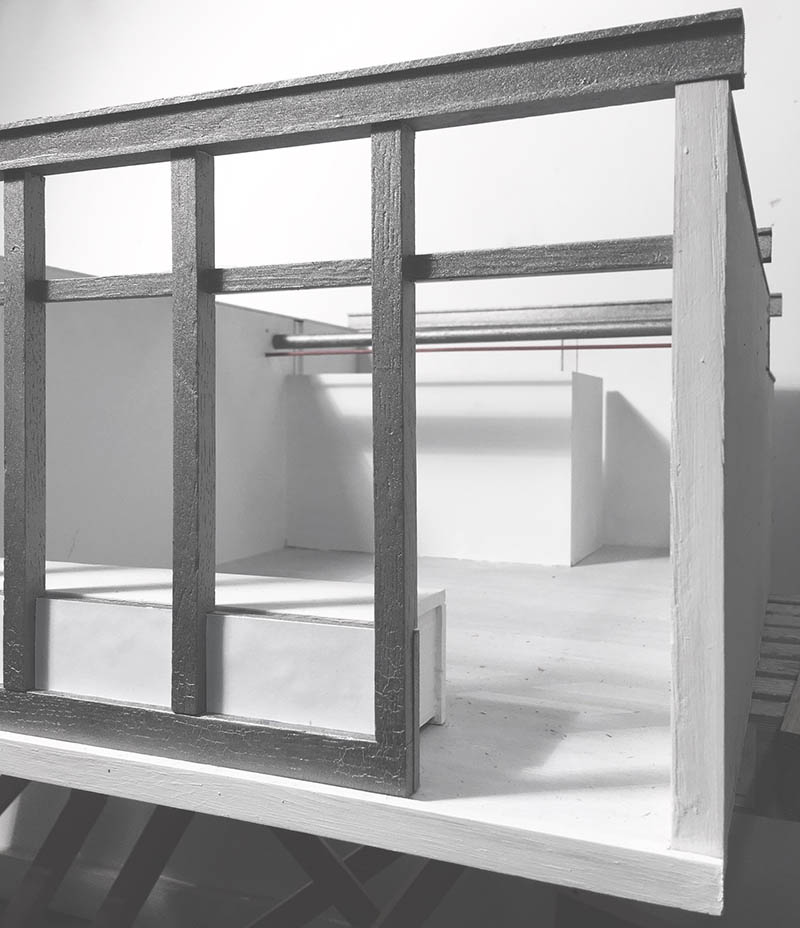 Odetta Petite. Photo by Seth Callandar
Odetta Petite. Photo by Seth Callandar
In the rear of the gallery is a wire maquette by Callander titled “After the Wreck”. It is part of series he calls “My Fathers’ Work”. These sculptures are reflections of the work of artists from all disciplines that have been his primary influences. “After the Wreck” is an interpretation of the work of John Chamberlain and influenced by Adrienne Rich’s poem, “Diving Into the Wreck”.
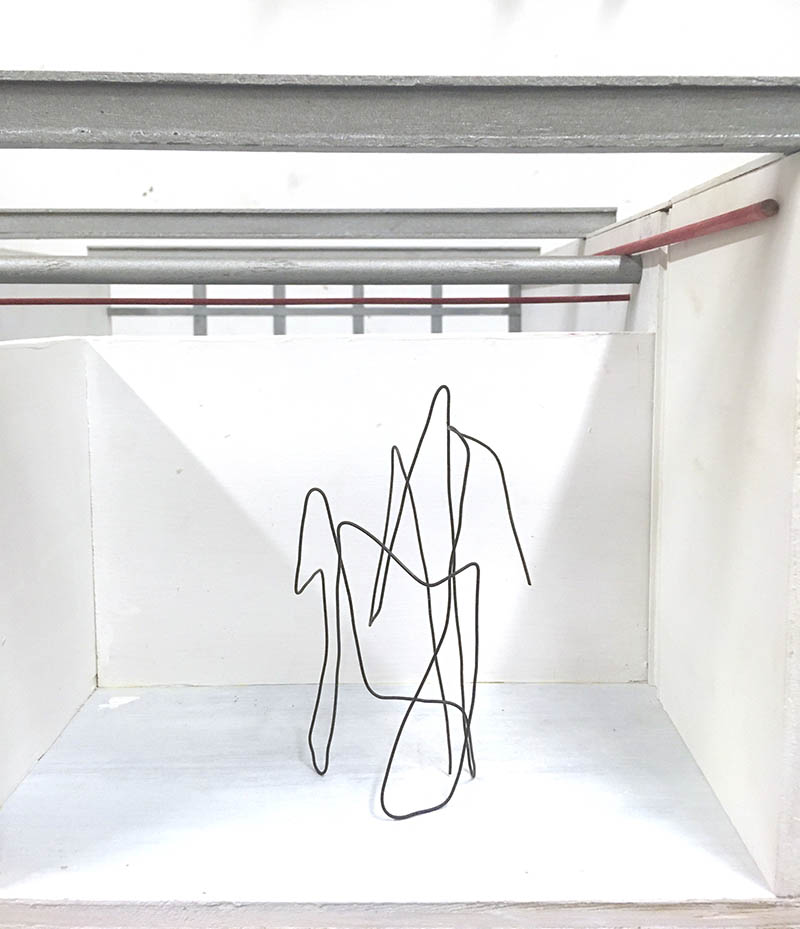 “After the Wreck” by Seth Callandar. Photo by Seth Callandar.
“After the Wreck” by Seth Callandar. Photo by Seth Callandar.
Others in Fagan’s stable will also exhibit in ODETTA Petite after Callander’s show is over. A site-specific sculptural installation by artist Liz Sweibel will fill the mini space next. Sweibel’s “The Human Toll” is a conceptional work based on the depth of the pandemic, and will run from November 1 until the end of the year. In the meantime Fagan will concurrently be running a gallery exhibit in her regular-sized gallery exhibition space, “Radical Women: Seeing Red” which opens August 26 in honor of the 100th anniversary of the passing of the 19h Amendment, by appointment only. A second fall exhibit is online with ODETTA Digital, a new branch of ODETTA, Inc.) titled “Pandemic Proof” and will run from September 11th until December 10, 2020. ODETTA Petite will be in Harlem August 26-Sept 26 by appointment only, other dates will be in Fagan’s Connecticut studio.
When you talk to Fagan there is an air of expectancy about Callander’s career. “He’s ready to do great work. He’s there.” And she equally hopes her farsighted vision will pay off for all of her artists. Her plan for ODETTA Petite is that it will function as a true model for the gallery, offering proposals for large-scaled sculptures and installations that will begin as online features for designers and architects to access for their private and corporate clients on commission. It will also be a source of entertainment and discussion from the stoop, dining room table… it’s portable!
As for Callander, he is buoyant too, amazed that the demoralizing pandemic brought the launch of an important new stage of his career. Untapped New York met with Callander on our own recent masked visit to his studio in New Haven, a short trip from the train station. Although most synonymous with Yale University and its ivy towers, the city has a fascinating industrial past dating to the Civil War.
Callander’s studio is in the supercool former Erector Set factory complex now called Erector Square and filled with working artists, many who have also fled from the stranglehold of New York City rent. This 11-building commercial complex is in the New Haven neighborhood of Fairhaven, and was established as a toy factory in 1923 by A.C. Gilbert, “the inventor and brains behind the metal, steel, nut and bolts” of the still-beloved Erector Set. According to Denny Daniel, founder of The Museum of Interesting Things, Gilbert was a magician, not an engineer, who had a Yale medical school degree and won an Olympic gold medal in pole vaulting. He started out making magic kits but switched to erector sets after he got a loan from his father. Gilbert’s “marketing genius soon made Erector Sets the toy to have,” says Daniel.
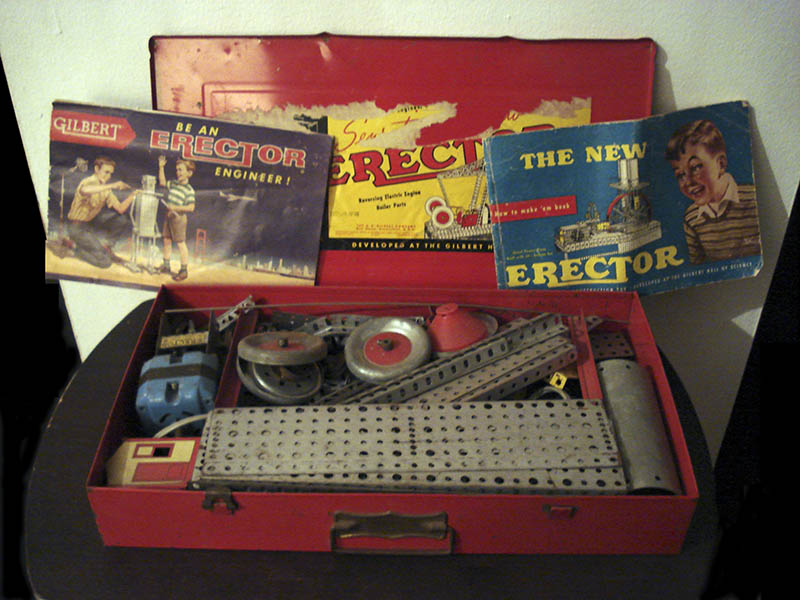 Erector Set belonging to Denny Daniel, founder of The Museum of Interesting Things. The Museum hosts a History of Toys Secret Speakeasy at least once a year where you can see items like the Erector Set.
Erector Set belonging to Denny Daniel, founder of The Museum of Interesting Things. The Museum hosts a History of Toys Secret Speakeasy at least once a year where you can see items like the Erector Set.
During Callandar’s first week at the old factory space, there was an open studio day at Erector Square and he was thrilled to met dozens of new and interesting people, not unlike the old days back in the East Village before gentrification. (The next one is October 19 & 20, if you want to check it out.)
And with Fagan’s support he is busy pricing material for larger sized pieces she is intent on selling. He plans to begin this fall with the realization of the wire piece, “After the Wreck,” in wood. It’s projected to be about 90” tall or approximately 7 ½ feet. Meanwhile, “The Waters We Swim,” the wooden maquette in ODETTA Petite, is too big to be realized in wood. It will be 7’ x 12’ x 22’ and crafted in aluminum or steel. “It is my hope that the full size piece will give a visitor the feeling of being tossed amidst the sea.”
With silvery hair and faded jeans dusty with woodchips, Callander still vaguely looks like that carpenter-with-other-talents, Harrison Ford. When pressed, Callandar admitted he had been compared to him in his youth. He leans against the wall, and marvels again over his fresh opportunity. “We live in a new world. Adversity can be where you find your voice.”
See Callandar’s exhibition at the ODETTA website and see more of Callandar’s work on his website.






